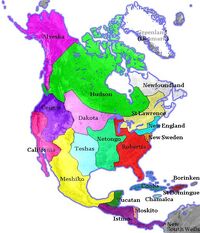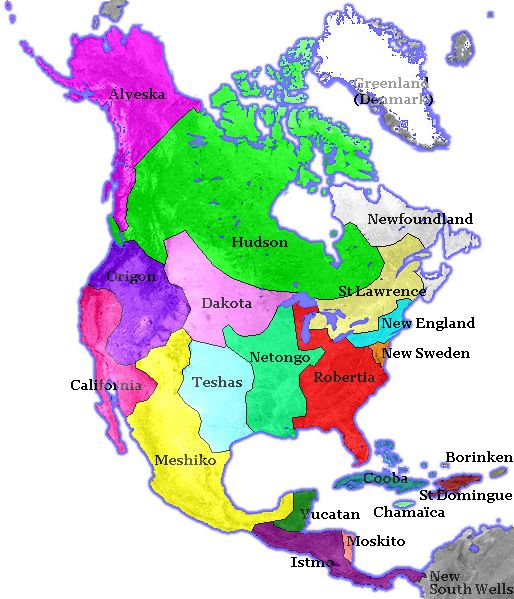Cabotia is a continent that lies in the Northern Hemisphere and is known OTL as North America.
Inhabited at least for 10,000 years, was discovered by John Cabot in 1497 AD. There is evidence, however, that Cabot was not the first European to came to Cabotia in the common era: The Vikings supposedly arrived to Cabotia circa 1000 AD.
In 1515, Ferdinand Magellan explored the Pacific Coast of Cabotia.
Claimed by the English, they plus the Dutch, the French and the Portuguese made several colonial settlements, displacing and subjugating several native cultures.
First European foundations[]
Cabot claimed Terranova on behalf of the English crown but the English did not settle there. The waters were frequently visited by fishers.
The first European settlements came in the Antilles: the Portuguese reached Borinken in 1512, and the French settled in Cooba (1515) and Saint Dominique (1517).
After the foundation of these settlements, the English begun exploring Terranova and southwards discovering and founding forts in the *St Lawrence (1519) mouth, *Cape Cod Bay (1521), *Manhattan (1522), and *Chesapeake Bay (1524). These forts were designed as trading posts with Native Cabotians, and as points of presence for other European powers.
After the histories on the Meshikan gold, the Europeans rushed southern Cabotia. The Dutch reached *Veracruz in 1523, establishing a fortified traiding post, and got recognition from Meshikan rulers in Tenochtitlan. The Dutch provided the Meshicans with steal, gunpowder weapons and horses in exchange for gold. French and English attempts were less successful.
In 1525, the Portuguese discovered the New World Isthmus founding the colony of Istmo and later that year California. The Portuguese also found a colony in the Neptunic coast of the Meshikan nation.
Most settlements in the 16th century were just fortified trading posts.
Other explorations during this century include the discovery of the Great Lakes and the Netongo river by the English (founding a few trading forts) and the French discovery of the Thule Strait.
Beginnings of European settlements[]
By 1600, some of the European trading posts had grew up becoming cities with permanent population of European origin, and claiming also surrounding land as farms using forced labor, mainly from Cabotian serfs and African slaves.
These main colonies, begun in Borinken, Istmo, Cooba, and Chesapeake. Also, disease decimated some native nations, opening up land for farming. The Europeans also had discovered that some small Cabotian and Brasilian nations were easy to defeat easing the task of grabbing gold. As the stories of people getting rich came back to Europe, more people wanted to go to Cabotia.
Following the religious persecutions of Puritans in England and Castile, and Catholics in France, in the early 17th century several groups crossed the Atlantic.
1605, a group of 124 French Catholics (men, women, and children) reached Florida in an attempt to reach for Cooba, and established a permanent colony.
A second group of 234 French Catholics, established in the northern islands of Cooba in 1609.
The puritans became, however, the greater influx. 54 English Puritans settled in the mouth of *Hudson River, in 1612 but the colony soon grew and by 1620, 694 Puritans had settled there, and 356 had settled in other places locations in eastern Cabotia.
Castilian Puritans founded a colony in the *Savannah River in 1619.
All these colonies begun growing by intermarriage with Natives (mainly the French catholic colonies), influx of new European refugees, and natural internal grow. By late 17th century, the eastern shore of Cabotia had 23 European settler colonies, including English Puritans, Castilian Puritans, French Catholics, Scot Catholics, and Danish Puritans all of them claiming autonomy from their European rulers. This added to the English trading colonies.
In the Northern Wars, English involvement against Sweden and Poland, lead to the transfer of the Chesapeake colony to Sweden. Sweden promoted the settlement of the colony, renamed Nya Svea (New Sweden), but by 1700 only few Swedes had settled, being mostly settled by Poles, Dutch, and English, as well as from peoples from other colonies in Cabotia.
The Istmo colony begun growing and attracting adventurers and farmers from Portugal, although some limited settlement of Castilians and Aragonese were allowed.
Nations of Cabotia[]
Antilles Sea[]
Isthmic Cabotia[]
Eastern Cabotia[]
Western Cabotia[]
- California
- Hudson
- Origon
- Western Thule


